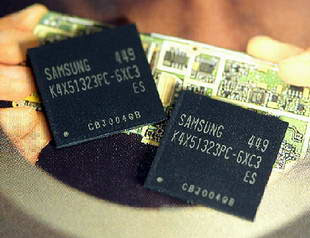D-RAM FINALLY FINDS A HOME IN MOBILE PHONES
The rapid uptake of smartphones around the world has ensured the future of DRAM (dynamic RAM) in mobile handsets, where the chips are used in every unit shipped.

Although it's not exactly like the version of DRAM used in PCs, it works in much the same way, and the differences are mainly in size, heat, and power consumption -- all key considerations in mobile phones, said Mueez Deen, director of Mobile DRAM and graphics memory, Samsung Semiconductor Inc.
For years, DRAM makers such as Samsung Electronics Co. Ltd. and Hynix Semiconductor Inc. have hoped to see the uptake of DRAM in mobile phones in order to win orders for the massive volume of the chips required by handsets. But standard DRAM made for computers uses too much power for mobile phones, so companies developed Mobile DRAM to take on the increasing computing power of today's smart handsets.
"Any time you have a feature-rich operating system, you need to have something to hold the OS, and on top of that have more memory to hold the other functions," said Deen in a telephone interview.
Mobile DRAM is currently used in about 30 percent of all mobile phones, he said,but in the future that figure will increase to almost every handset, as the devicestakeon more computing functions.
It's a very different story from a decade ago. The main memory chips used in a mobile phone ten years ago were NOR Flash memory and SRAM (synchronous-RAM). SRAM was ideal as a low power memory chip for handsets, but manufacturers complained about its cost relative to DRAM, and many hoped to see DRAM transform into a replacement for SRAM in handsets.
It's been a tough battle for DRAM makers to tweak their product for the mobile market, but the development effort did help them create chips able to use less power than standard DRAM, that takes up less space inside a handset. Deen said Mobile DRAM is completely different than DRAM, a re-design from the ground up.
However, SRAM continues to hold the lion's share of the mobile phone market, mainly because most handsets being shipped today still do not host functions that require Mobile DRAM.
But new products such as the iPhone are turning the tide increasingly to Mobile DRAM. Handsets that act as a PDA (personal digital assistant), or smartphones, as well as mobile devices used for e-mail, listening to music and ever more multimedia functions require more capacity and speed in a memory chip than SRAM can provide, giving Mobile DRAM a leg up.In fact, the iPod is also a major driver of Mobile DRAM growth. Digital music players require Mobile DRAM to buffer the data. Whether it's audio or video, small devices need Mobile DRAM,said Deen, although video needs even more.
As time goes on, more mobile phones, even low-end handsets aimed at emerging markets, will add multimedia and PDA-like functionality, ensuring the future for Mobile DRAM, Deen said.

Although it's not exactly like the version of DRAM used in PCs, it works in much the same way, and the differences are mainly in size, heat, and power consumption -- all key considerations in mobile phones, said Mueez Deen, director of Mobile DRAM and graphics memory, Samsung Semiconductor Inc.
For years, DRAM makers such as Samsung Electronics Co. Ltd. and Hynix Semiconductor Inc. have hoped to see the uptake of DRAM in mobile phones in order to win orders for the massive volume of the chips required by handsets. But standard DRAM made for computers uses too much power for mobile phones, so companies developed Mobile DRAM to take on the increasing computing power of today's smart handsets.
"Any time you have a feature-rich operating system, you need to have something to hold the OS, and on top of that have more memory to hold the other functions," said Deen in a telephone interview.
Mobile DRAM is currently used in about 30 percent of all mobile phones, he said,but in the future that figure will increase to almost every handset, as the devicestakeon more computing functions.
It's a very different story from a decade ago. The main memory chips used in a mobile phone ten years ago were NOR Flash memory and SRAM (synchronous-RAM). SRAM was ideal as a low power memory chip for handsets, but manufacturers complained about its cost relative to DRAM, and many hoped to see DRAM transform into a replacement for SRAM in handsets.
It's been a tough battle for DRAM makers to tweak their product for the mobile market, but the development effort did help them create chips able to use less power than standard DRAM, that takes up less space inside a handset. Deen said Mobile DRAM is completely different than DRAM, a re-design from the ground up.
However, SRAM continues to hold the lion's share of the mobile phone market, mainly because most handsets being shipped today still do not host functions that require Mobile DRAM.
But new products such as the iPhone are turning the tide increasingly to Mobile DRAM. Handsets that act as a PDA (personal digital assistant), or smartphones, as well as mobile devices used for e-mail, listening to music and ever more multimedia functions require more capacity and speed in a memory chip than SRAM can provide, giving Mobile DRAM a leg up.In fact, the iPod is also a major driver of Mobile DRAM growth. Digital music players require Mobile DRAM to buffer the data. Whether it's audio or video, small devices need Mobile DRAM,said Deen, although video needs even more.
As time goes on, more mobile phones, even low-end handsets aimed at emerging markets, will add multimedia and PDA-like functionality, ensuring the future for Mobile DRAM, Deen said.
Reference: wireless.itworld.com




